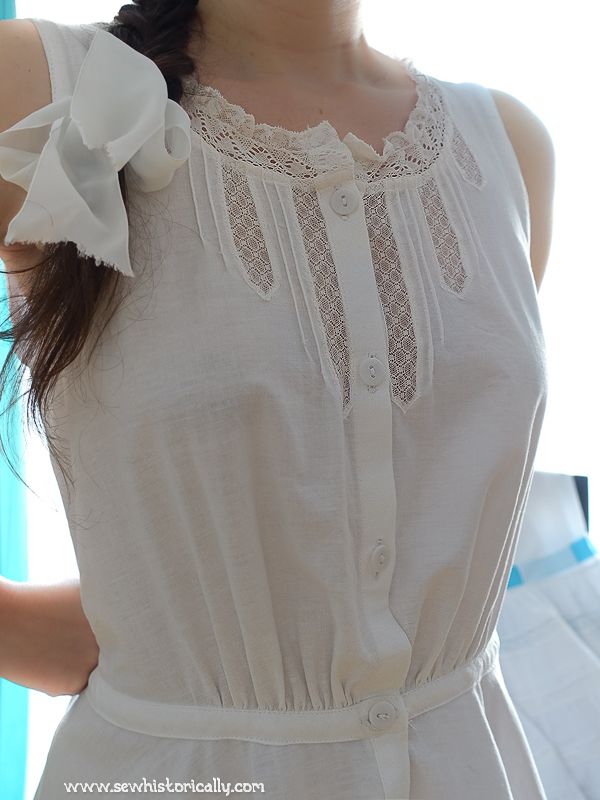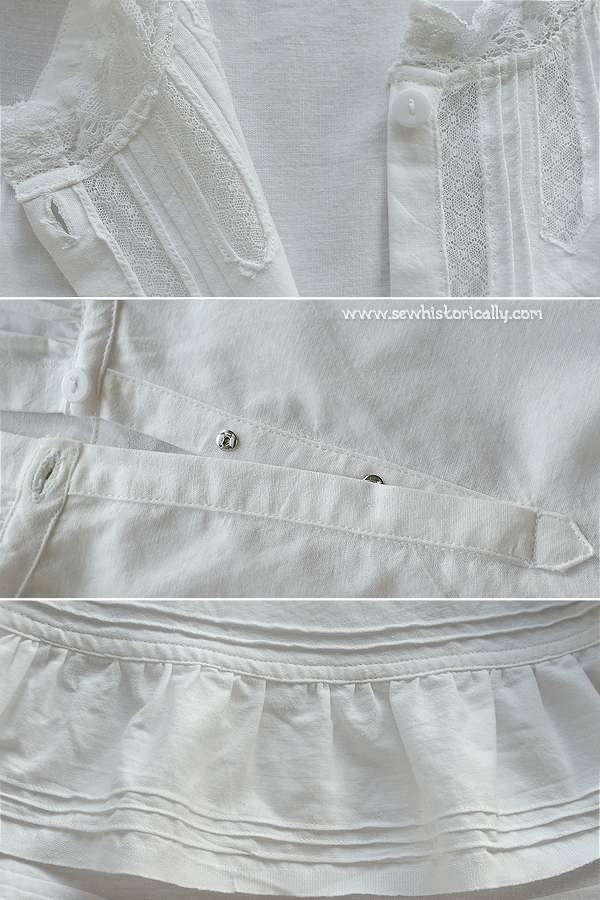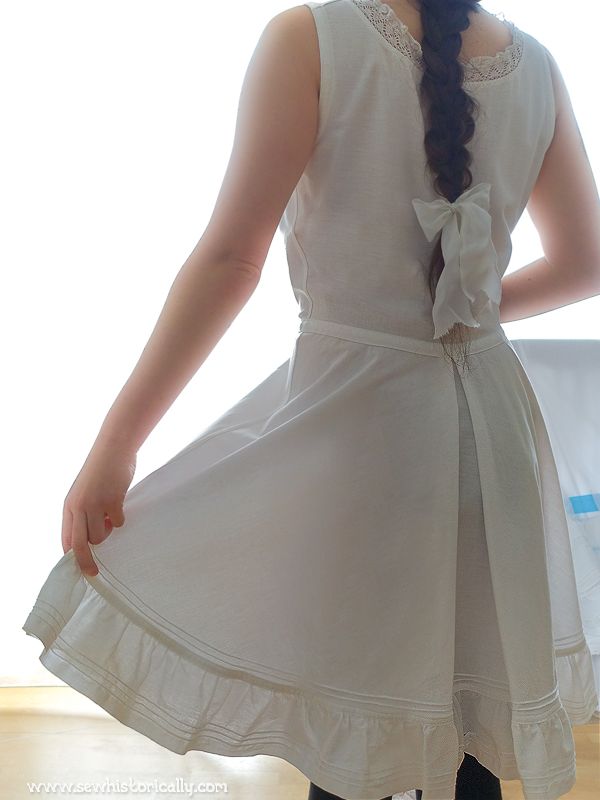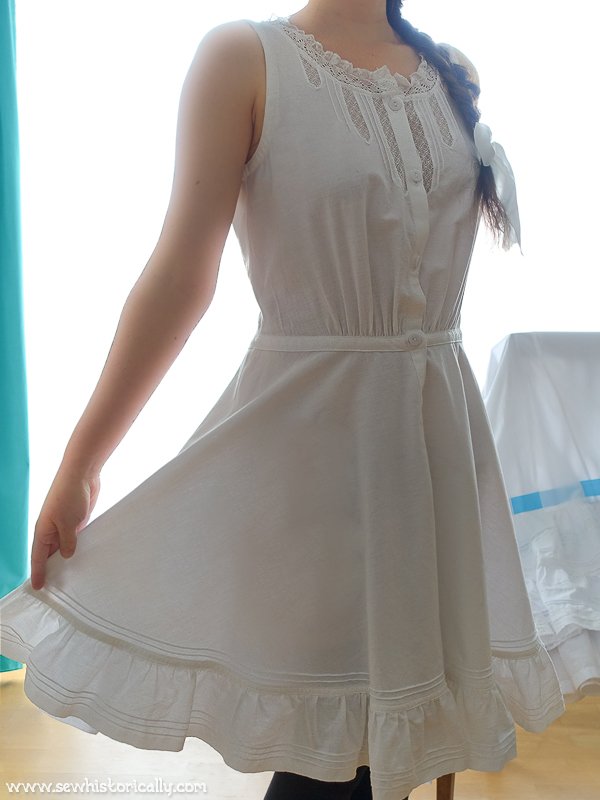The Edwardian era is my favorite historical era at the moment, that’s why I made another piece of Edwardian underwear! 😀 You could call this piece of lingerie a slip, chemise, princess slip or princess petticoat. And in the Edwardian era, it was also called ‘combination chemise and short petticoat’. It combined the corset cover and short under petticoat into one garment and was usually worn over the chemise and corset.
‘Ladies’ Chemise or Corset-Cover and Under-Skirt in One’ (White Wear For Ladies, Misses And Children, 1905).
My Edwardian lace slip was also a stash buster project: I used small lace scraps for the lace inserts at the front and the lace trim at the neck. And the fabric was a bed sheet before! 😉 My Edwardian lace slip is made of 100% cotton, including the lace, and I used only period correct sewing techniques.
And even though it’s an Edwardian piece of lingerie, I wear it today as summer dress because it would be a shame to hide this lacy slip in the closet! 😀 Incorporating historical garments into today’s wardrobe is known as ‘history bounding’.
My Inspirations
My Edwardian slip is inspired by antique Edwardian slips with a fitted waist like this antique Edwardian lace slip, or this 1900s slip, this broderie anglaise slip or this Edwardian slip. The lace inserts with pintucks at the front are inspired by the following antique Edwardian corset covers and slips: lace corset cover, 1904 corset cover, another lace corset cover and chemise.
-> More Inspirations On My Pinterest Board “1900s Lingerie”
‘Shapely corset covers that fit nicely yet are not over snug are in constant demand and never can be too numerous. This one is peculiarly pretty and attractive […] with insertion and […] narrow tucks’ (Los Angeles Herald, 1904)

Fabric
As I’ve already mentioned, I used an off-white cotton bed sheet from my grandma. The fabric is coarsely woven but drapes softly. It might be similar to longcloth – a popular underwear fabric in the Edwardian era. I have an antique Edwardian lace slip in my possession that is made of a similar fabric.
Related: Antique Edwardian Lace Slip
‘Long Cloth is a fine cotton fabric made in a great many different qualities. It is very soft, coarsely woven and is used a great deal in making underwear and infants’ clothing. It closely resembles cambric and muslin.’ (School Sewing Based On Home Problems, 1916)
Embellishment: Lace & Pintucks
My Edwardian slip has lace inserts alternating with pintucks at the front like on this antique corset cover at the V&A museum. I used cotton Valenciennes lace scraps from my stash: It was just enough for the lace inserts! I inserted the lace with tiny hems (lace insert method 1 if you click on the link below).
Related: 6 Ways How To Insert Lace – Heirloom Sewing Tutorial
After finishing the raw edges on the neck with a small hem, I used more cotton lace scraps from my stash to decorate the neck. I sewed the lace around the neck with overhand stitches by hand. Then I drew one of the lace threads tight to adjust the lace trim to the curve of the neck. And for the small lace ruffle at the neck, I used 8 short cotton Valenciennes lace scraps that I joined with an invisible seam.
Related: How To Join Lace – Invisible Seam
The hem of Edwardian slips and petticoats were often embellished with tucks and pintucks to stiffen the hem like this 1900s slip with pintucks at the skirt & hem ruffle or this Edwardian slip with a plain ruffle with pintucks. That’s why I also embellished the ruffle of my Edwardian slip with 3 rows and the skirt with two rows of pintucks.
Button Closure
Edwardian princess slips and combination suits were usually either closed with buttons or snaps.
‘Buttonholes and buttons are the best fastenings for most undergarments because they launder well, wear well, and may be an interesting part of the design of the closing of a garment. […] buttonholes […] are generally placed vertically in the garment and are used where there is not much strain’ (A Manual Of Home-Making, 1919).
My Edwardian slip is closed at the center front with 4 buttons above the waist and 2 snaps below the waist. I used snaps to close the placket below the waist so that they are invisible from the outside.

Bias Facing
I used self-fabric bias facing to finish the armholes and waist – a historically correct finishing method. The armholes of this antique Edwardian chemise are bound with self-fabric bias facing.
‘A bias facing is sometimes used to finish the arm-hole of a corset cover before sewing on lace. It is a strong finish […] […] To apply a bias facing […] place the right side of the facing to the right side of the garment […] stitch and turn directly on the edge […] Turn in the raw edge of facing, […] finish with machine stitching’ (Clothing For Women: Selection, Design, Construction, 1916).
Pouter Pigeon Shape
To create the fashionable Edwardian pouter pigeon shape, I gathered the bodice of my Edwardian slip at the front before I attached the waistband.
‘Beginning 2 1/2″ from the under-arm seams, gather the front pieces along the lower edge to the hems on the front. Adjust the gathers so the bottom of the corset cover will be the same size as the waist measure, allowing 1″ extra for the lapping of the band in front.’ (School Sewing Based On Home Problems, 1916)
And, like most Edwardian combinations, the skirt has an inverted box pleat at the center back so that it’s wide enough to drape over the corset.

Hem Circumference
My Edwardian slip has a circle skirt and a straight ruffle at the hem. The circle skirt part of the slip is 120″ (305cm) wide and the ruffle is 177″ (450cm) wide.
Receiving Tuck
In the Edwardian era, petticoat ruffles were usually attached with a receiving tuck. The receiving looks like a tuck and encases the raw fabric edges between the two layers of fabric. So there are no raw fabric edges on either the right or wrong side similar to a flat felled seam.
Related: 5 Ways To Attach Ruffles – Historical & Heirloom Sewing
‘The ruffles may be put on (a) by means of the receiving tuck, (b) by means of finishing braid, or (c) by means of a French seam. The first of these is the method most used.’ (Garments For Girls, 1919)
I also attached the hem ruffle with a receiving tuck. And all other seams are finished with flat felled seams – the typical Edwardian lingerie seam.
